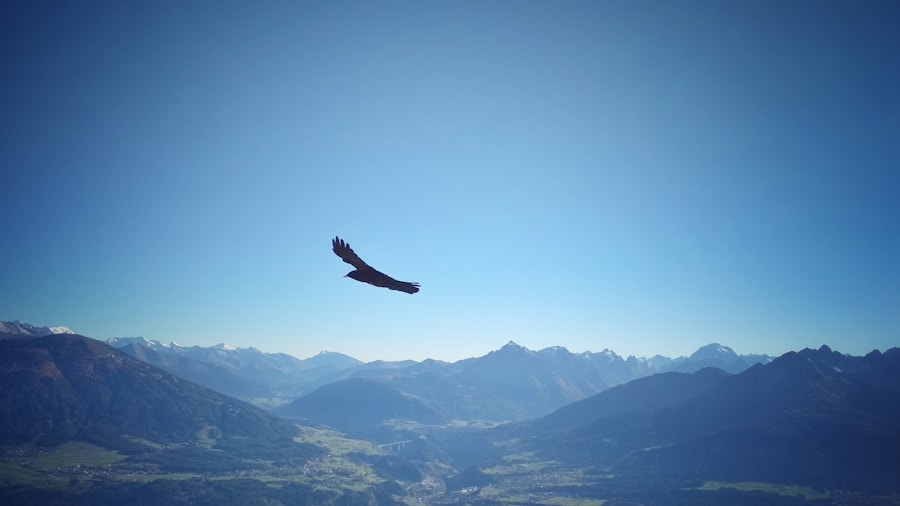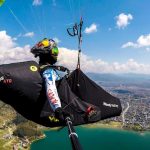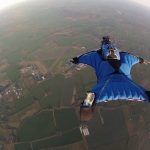Download links
How to install Soaring to New Heights: The Thrill of Wingsuit Flying APK?
1. Tap the downloaded Soaring to New Heights: The Thrill of Wingsuit Flying APK file.
2. Touch install.
3. Follow the steps on the screen.
Description
Wingsuit flying, a breathtaking blend of human ingenuity and the primal desire for flight, has a rich history that dates back to the early 20th century. The concept of gliding through the air with the aid of a suit designed to increase surface area can be traced back to the pioneering work of early aviators and inventors. One of the first recorded instances of a wingsuit-like apparatus was in 1912 when French inventor Franz Reichelt attempted to fly from the Eiffel Tower using a parachute suit.
Although his endeavor ended tragically, it laid the groundwork for future innovations in human flight. The modern wingsuit, however, began to take shape in the late 1990s, thanks to the efforts of skydivers who sought to extend their freefall experience. The first wingsuits were rudimentary, often resembling a simple jumpsuit with fabric wings attached between the arms and legs.
These early designs allowed for limited horizontal movement and were primarily used by experienced skydivers looking to add an extra thrill to their jumps. As technology advanced, so did the design of wingsuits, leading to more sophisticated models that offered improved aerodynamics and control. By the early 2000s, wingsuit flying had gained popularity as a distinct sport, attracting enthusiasts from various backgrounds who were eager to experience the sensation of soaring through the skies.
Key Takeaways
- Wingsuit flying originated in the late 1990s as an evolution of skydiving and BASE jumping, with the first successful wingsuit flight taking place in 1997.
- The physics behind wingsuit flying involves the concept of lift and drag, where the wingsuit design allows the flyer to generate lift and control their descent.
- Training for wingsuit flying is rigorous and includes extensive skydiving and BASE jumping experience, as well as safety measures such as using proper equipment and understanding weather conditions.
- Top destinations for wingsuit flying include the Swiss Alps, the Dolomites in Italy, and the mountains of Norway, offering breathtaking scenery and challenging terrain for experienced flyers.
- Wingsuit flying provides an unparalleled adrenaline rush, with flyers experiencing a sense of freedom and exhilaration as they soar through the air at high speeds.
- The future of wingsuit flying includes advancements in wingsuit design, safety technology, and the potential for wingsuit racing as a competitive sport.
The Physics Behind Wingsuit Flying
Understanding the physics behind wingsuit flying is essential for both safety and performance. At its core, wingsuit flying relies on the principles of aerodynamics, particularly lift and drag. When a wingsuit pilot jumps from an aircraft, they enter freefall, and their body begins to interact with the surrounding air.
The wingsuit is designed to create lift by increasing the surface area exposed to airflow. This lift allows the pilot to glide horizontally rather than simply falling straight down, enabling them to cover significant distances during their descent. The design of a wingsuit plays a crucial role in its performance.
Modern wingsuits are crafted from lightweight materials and feature specific shapes that optimize airflow. The wings are typically constructed with a combination of rigid and flexible materials, allowing them to maintain their shape while also adapting to changes in air pressure. As the pilot maneuvers through the air, they can adjust their body position to control their trajectory and speed.
For instance, by angling their arms and legs, they can increase or decrease lift, allowing for more precise navigation during flight. This intricate dance with physics is what makes wingsuit flying both exhilarating and complex.
The Training and Safety Measures for Wingsuit Flying

Training for wingsuit flying is a rigorous process that requires dedication, skill, and a thorough understanding of skydiving fundamentals. Before even considering a wingsuit jump, aspiring pilots must complete a series of skydiving jumps with a standard parachute. Most organizations recommend a minimum of 100 jumps before transitioning to wingsuit flying, as this experience helps develop essential skills such as body control, awareness of altitude, and emergency procedures.
Once a skydiver has met the prerequisites, they typically undergo specialized wingsuit training programs. These programs often include ground school sessions that cover the mechanics of wingsuit flight, safety protocols, and emergency procedures specific to wingsuiting. Additionally, many training courses incorporate supervised jumps with experienced instructors who provide real-time feedback on body positioning and flight techniques.
For instance, they learn how to handle malfunctions with their wingsuit or parachute and practice emergency landings in controlled environments.
The Top Destinations for Wingsuit Flying
| Destination | Country | Altitude (ft) | Distance (miles) |
|---|---|---|---|
| Chamonix | France | 12,605 | 2.5 |
| Lauterbrunnen | Switzerland | 9,744 | 2.2 |
| Wingsuit Flying | Italy | 13,123 | 2.8 |
| Base Jumping | Norway | 6,000 | 1.5 |
Wingsuit flying offers enthusiasts the opportunity to experience some of the most breathtaking landscapes on Earth from an entirely unique perspective. Certain locations have become renowned for their ideal conditions and stunning backdrops, attracting wingsuit pilots from around the globe.
” The dramatic cliffs and picturesque scenery provide an exhilarating setting for wingsuit flights, allowing pilots to navigate through narrow canyons while enjoying panoramic views of the Swiss Alps.
Another popular location is the Troll Wall in Norway, which boasts Europe’s tallest vertical rock face. The sheer drop offers an adrenaline-pumping experience as pilots launch themselves off the cliff into the open air. The combination of altitude and stunning fjord views makes it a favorite among experienced wingsuit flyers.
In addition to these iconic sites, many pilots seek out remote mountain ranges or coastal cliffs where they can enjoy solitude and natural beauty while engaging in their sport. Each destination presents its own set of challenges and rewards, making wingsuit flying an ever-evolving adventure.
The Adrenaline Rush of Wingsuit Flying
The adrenaline rush associated with wingsuit flying is unparalleled, drawing individuals who crave extreme sports and adventure. As pilots leap from an aircraft or cliff face, they experience an immediate surge of excitement as they plunge into freefall. The sensation of soaring through the air at high speeds while maneuvering through the sky creates an intoxicating blend of fear and exhilaration that few other activities can replicate.
During flight, pilots often describe a profound sense of freedom as they glide effortlessly through the air. The ability to control their trajectory and speed adds an element of thrill that is both empowering and exhilarating. Many wingsuit flyers report that this experience transcends mere adrenaline; it becomes a meditative state where they feel completely in tune with their surroundings.
The rush continues even after deploying their parachute, as they transition from high-speed flight to a gentle descent, allowing them to savor the beauty of their surroundings before landing safely on solid ground.
The Future of Wingsuit Flying: Innovations and Advancements

As technology continues to evolve, so too does the world of wingsuit flying. Innovations in materials science have led to lighter and more durable fabrics that enhance performance while ensuring safety. Manufacturers are experimenting with new designs that improve aerodynamics and control, allowing pilots to achieve greater distances and more complex maneuvers during flight.
Additionally, advancements in wearable technology are beginning to make their mark on the sport. Pilots can now utilize heads-up displays (HUDs) that provide real-time data on altitude, speed, and trajectory directly within their line of sight. This information can be crucial for making split-second decisions during flight and enhancing overall safety.
Furthermore, developments in drone technology are paving the way for new training methods; drones equipped with cameras can capture aerial footage of flights, providing valuable insights for pilots looking to refine their techniques. The future of wingsuit flying is not only about enhancing performance but also about expanding accessibility. As interest in extreme sports grows, more organizations are offering training programs that cater to beginners while maintaining rigorous safety standards.
This democratization of wingsuit flying could lead to an influx of new enthusiasts eager to experience the thrill of flight. With ongoing innovations in equipment and training methodologies, wingsuit flying is poised for continued growth as both a sport and an art form that captivates adventurers around the world.
FAQs
What is wingsuit flying?
Wingsuit flying is a skydiving discipline where participants wear a special jumpsuit that adds surface area to the human body, enabling a significant increase in lift. This allows the participant to glide through the air at a much slower descent rate than a traditional skydiver.
How does a wingsuit work?
A wingsuit works by creating additional surface area with fabric between the arms and body, as well as between the legs. This increased surface area allows the participant to generate lift and glide through the air, rather than simply free-falling like a traditional skydiver.
What are the risks of wingsuit flying?
Wingsuit flying carries inherent risks due to the high speeds and proximity to the ground or other objects. Accidents can occur due to collisions with obstacles, failure to deploy the parachute in time, or loss of control during flight. It is considered an extreme sport and should only be attempted by experienced skydivers.
What training is required for wingsuit flying?
To participate in wingsuit flying, individuals must first become experienced skydivers and obtain a minimum number of skydives before undergoing specialized wingsuit training. This training includes learning how to control the wingsuit, proper deployment of the parachute, and safety procedures specific to wingsuit flying.
Where can one go wingsuit flying?
Wingsuit flying can be done at various skydiving centers and drop zones around the world. However, not all skydiving facilities may offer wingsuit training or allow wingsuit flying due to the specialized nature of the discipline. It is important to research and find a reputable facility with experienced instructors.





